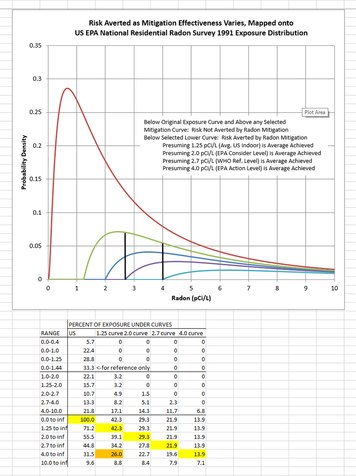-
 Jeff Miner
20What % of radon induced lung cancers come from homes with under 4 pC/l? I have heard it is 80% but I do not have the source.
Jeff Miner
20What % of radon induced lung cancers come from homes with under 4 pC/l? I have heard it is 80% but I do not have the source. -
 Gail Orcutt
4Dr. Field has told me that 1/3 of those who die of radon-induced lung cancer in our state were living with a level between 2-4 pCi/L.
Gail Orcutt
4Dr. Field has told me that 1/3 of those who die of radon-induced lung cancer in our state were living with a level between 2-4 pCi/L. -
 Henri Boyea
110Jeff, I don't think that is possible to define, as very few lung cancer patients have lived in the same house their entire lives, and radon concentrations vary over time. As Dr, Field's document states, the data is more accurate with study participants who move less, and those that have data from previous homes. One could make a correlation between incidence of lung cancer and radon concentrations in the homes occupied by the patients at time of diagnosis, but I don't see much value in that.
Henri Boyea
110Jeff, I don't think that is possible to define, as very few lung cancer patients have lived in the same house their entire lives, and radon concentrations vary over time. As Dr, Field's document states, the data is more accurate with study participants who move less, and those that have data from previous homes. One could make a correlation between incidence of lung cancer and radon concentrations in the homes occupied by the patients at time of diagnosis, but I don't see much value in that. -
 Jeff Miner
20Thank you all for weighing in. I think a simplified way of saying it might be Gail Orcutt's comment that 1/3 of those who die from radon-induced lung cancer were living with a level between 2-4 pCi/L. And data from Bill Field's reports that stated Most Radon-Induced Lung Cancers Occur Below the U.S. EPA’s Radon Action Level. I think I would be within the bounds of good science using these statements.
Jeff Miner
20Thank you all for weighing in. I think a simplified way of saying it might be Gail Orcutt's comment that 1/3 of those who die from radon-induced lung cancer were living with a level between 2-4 pCi/L. And data from Bill Field's reports that stated Most Radon-Induced Lung Cancers Occur Below the U.S. EPA’s Radon Action Level. I think I would be within the bounds of good science using these statements. -
 Kevin M Stewart
97Looking at Bill's report to the President's Cancer Panel, as he attached, I see a statement therein is equivalent to saying that one-third of the US radon-induced lung cancers occur from exposures at 4 pCi/L or above, and one-half of US radon-induced lung cancer deaths from exposures above 2 pCi/L. Presuming cases and deaths to be partitioned by those proportions among the exposure categories, therefore only about one-sixth of each would fall into the exposure range from 2 to 4 pCi/L, if we use those estimates from BEIR VI.
Kevin M Stewart
97Looking at Bill's report to the President's Cancer Panel, as he attached, I see a statement therein is equivalent to saying that one-third of the US radon-induced lung cancers occur from exposures at 4 pCi/L or above, and one-half of US radon-induced lung cancer deaths from exposures above 2 pCi/L. Presuming cases and deaths to be partitioned by those proportions among the exposure categories, therefore only about one-sixth of each would fall into the exposure range from 2 to 4 pCi/L, if we use those estimates from BEIR VI.
While I recognize that an improved basis for my estimate is needed, using a smoothed log-normal distribution of the 1991 NRRS, I got a value (31.5%) essentially equal to the "one-third above 4 pCi/L" rule-of-thumb value. The attached shows my results and can also give readers some idea of the relative effectiveness of different mitigation thresholds on lung cancer risk averted. For example, getting all residences down only to 4 pCi/L averts only 14% of radon-induced lung cancer, but mitigating down to a value of 1.25 pCi/L -- demonstrably achievable in nearly all cases -- could avert about 42% of those deaths.
Anyway, by this analysis, about a quarter (24%) of radon-induced lung cancers would result from exposures in the 2 to 4 pCi/L range, a value about the average of the "third" and the "sixth" fractions given above in this thread. Also note that the exposure curve gives a value in the neighborhood of 1.44 pCi/L for an exposure below which one third of radon-induced lung cancers in the US would be found, presuming strict LNT. (Keep in mind that the graph shows the distribution density for Exposure, not for Frequency of occurrence.)Attachment Estimates Risk Averted vs. Mitigation Effectiveness w US NRRS 1991 Exposure Dist
(225K)
Estimates Risk Averted vs. Mitigation Effectiveness w US NRRS 1991 Exposure Dist
(225K)

Welcome to the Radon ListServ!
Join Radon ListServ Categories that pique your interests and area of expertise.
More Discussions
- Terms of Service
- Useful Hints and Tips
- Sign In
- © 2025 Radon ListServ






